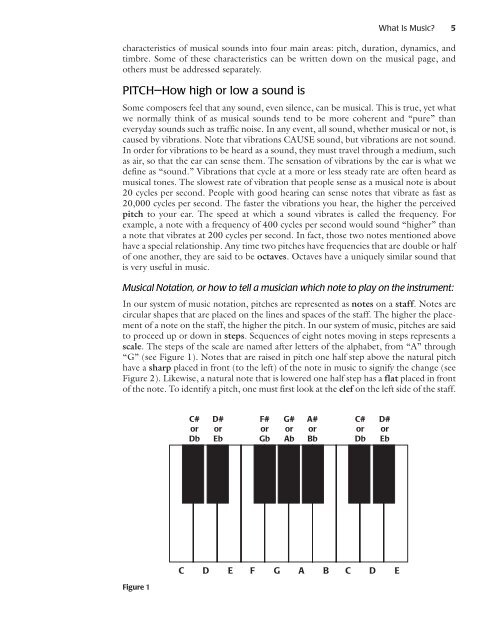Composer Profile - Activefolio
Composer Profile - Activefolio
Composer Profile - Activefolio
Create successful ePaper yourself
Turn your PDF publications into a flip-book with our unique Google optimized e-Paper software.
What Is Music? 5<br />
characteristics of musical sounds into four main areas: pitch, duration, dynamics, and<br />
timbre. Some of these characteristics can be written down on the musical page, and<br />
others must be addressed separately.<br />
PITCH—How high or low a sound is<br />
Some composers feel that any sound, even silence, can be musical. This is true, yet what<br />
we normally think of as musical sounds tend to be more coherent and “pure” than<br />
everyday sounds such as traffic noise. In any event, all sound, whether musical or not, is<br />
caused by vibrations. Note that vibrations CAUSE sound, but vibrations are not sound.<br />
In order for vibrations to be heard as a sound, they must travel through a medium, such<br />
as air, so that the ear can sense them. The sensation of vibrations by the ear is what we<br />
define as “sound.” Vibrations that cycle at a more or less steady rate are often heard as<br />
musical tones. The slowest rate of vibration that people sense as a musical note is about<br />
20 cycles per second. People with good hearing can sense notes that vibrate as fast as<br />
20,000 cycles per second. The faster the vibrations you hear, the higher the perceived<br />
pitch to your ear. The speed at which a sound vibrates is called the frequency. For<br />
example, a note with a frequency of 400 cycles per second would sound “higher” than<br />
a note that vibrates at 200 cycles per second. In fact, those two notes mentioned above<br />
have a special relationship. Any time two pitches have frequencies that are double or half<br />
of one another, they are said to be octaves. Octaves have a uniquely similar sound that<br />
is very useful in music.<br />
Musical Notation, or how to tell a musician which note to play on the instrument:<br />
In our system of music notation, pitches are represented as notes on a staff. Notes are<br />
circular shapes that are placed on the lines and spaces of the staff. The higher the placement<br />
of a note on the staff, the higher the pitch. In our system of music, pitches are said<br />
to proceed up or down in steps. Sequences of eight notes moving in steps represents a<br />
scale. The steps of the scale are named after letters of the alphabet, from “A” through<br />
“G” (see Figure 1). Notes that are raised in pitch one half step above the natural pitch<br />
have a sharp placed in front (to the left) of the note in music to signify the change (see<br />
Figure 2). Likewise, a natural note that is lowered one half step has a flat placed in front<br />
of the note. To identify a pitch, one must first look at the clef on the left side of the staff.<br />
Figure 1<br />
C# D# F# G# A# C# D#<br />
or or or or or or or<br />
Db Eb Gb Ab Bb Db Eb<br />
C D E F G A B C D E



